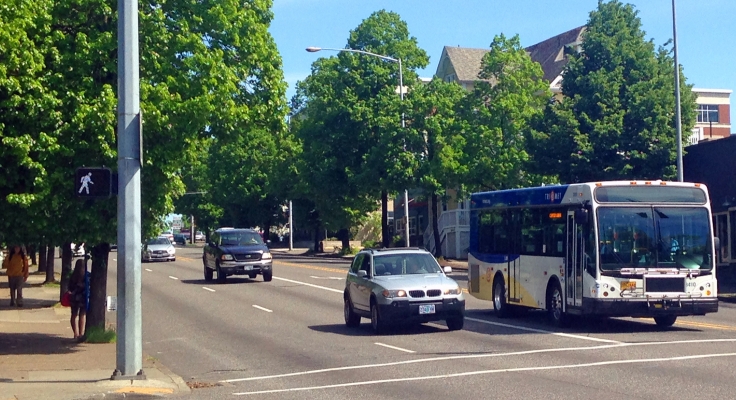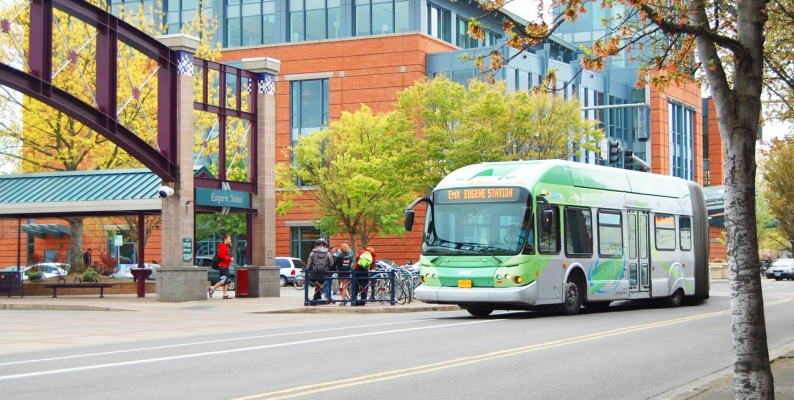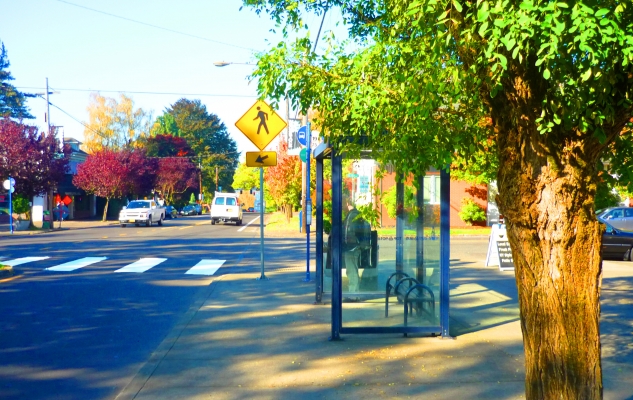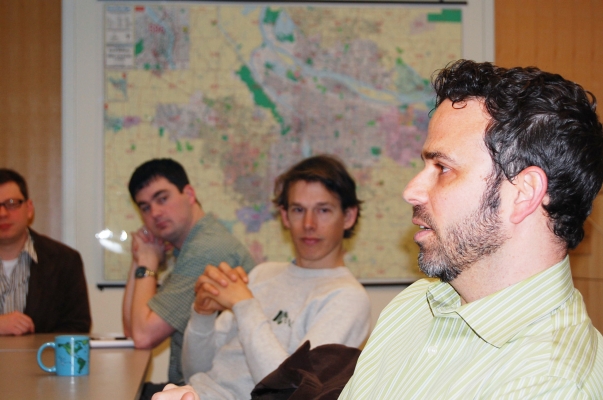Painted as the “next big thing” in transit, bus rapid transit systems have the luster of a new concept -- and the lack of research literature to match. A NITC research project set out to change that, producing a far-ranging research report delving into the influence of BRT on jobs, housing and development.
Bus Rapid Transit systems occupy a space between regular bus and light rail systems. Like regular bus systems, BRT systems typically use rubber tires and internal combustion engines and run on paved roads. However, the systems may share many features with light-rail trains, including exclusive lanes, off-vehicle payment systems and low floors and large doors for quicker boarding.
Led by Arthur C. Nelson at the University of Utah’s Metropolitan Research Center, the project, “National Study of BRT Development Outcomes,” looked at systems around the country, finding evidence that BRT systems influence development patterns in important ways. The research found that BRT systems are tied to positive outcomes for development and job location, although not necessarily changes in population or housing.
Bus rapid transit systems hold the promise of bringing communities some of the positive outcomes traditionally associated with light-rail transit systems but at a lower cost. The research will be of interest to...
In recent decades, Bus Rapid Transit (BRT) has gained popularity across the United States due to its relatively low costs of development (compared to the investment requirements of putting in a new light rail system, for example) and its potential to drive economic development.
However, there is a need for more comprehensive research devoted to understanding its economic impacts across various sectors.
NITC researcher Joanna Ganning is the lead author on a research paper that will be presented at the annual meeting of the Transportation Research Board this month, which seeks to estimate the effects of BRT stations on employment growth.
Using Longitudinal Employer-Household Dynamics data, Ganning and her research team investigated the impacts of BRT on employment changes of each major industry sector between 2002 and 2010.
The researchers analyzed employment data surrounding 226 BRT stations along nine BRT corridors which were opened during the study period, as well as employment data from equally sized areas around control points.
Metropolitan areas included in the analysis were Phoenix, Los Angeles, Kansas City, Las Vegas, Salt Lake City, New York City, Cleveland, Ohio and Eugene, Oregon.
With the presence or absence of BRT stations as the independent variable, the team found that BRT statistically significantly influenced employment change for just one...
Read moreThe U.S. Department of Housing and Urban Development has identified some “livability principles” which include healthy, safe and walkable neighborhoods and safe, reliable and economical transportation choices.
Transit agencies and local governments routinely use metrics to evaluate the performance of transit systems, but a uniform standard of transit data collection does not exist outside of the reporting requirements of the National Transit Database (NTD). Because of the types of data collected for the NTD, the focus of performance measurements is often on ridership and financial performance, leaving aside the question of livability.
In a new project sponsored by OTREC, Principal Investigator Marc Schlossberg, associate professor in the department of planning, public policy and management at the University of Oregon, along with co-investigators Jennifer Dill of Portland State University and Nico Larco, also of the University of Oregon, set out to create a set of tested and refined performance indicators that transit agencies across the nation can use to evaluate and improve their system performance in relation to livability goals.
Traditionally, transit systems are thought of exclusively in their wholeness: how the system serves a region,...
Read moreFor transit planning expert Jarrett Walker, one of the fundamentals of transit is also one of the hardest points for people to figure out: you can’t make good transit-system decisions from behind the wheel of a car.
“If you’re a habitual motorist, it doesn’t matter how much you support transit, there are certain things about it you’re not likely to get,” Walker said. “One the most basic, if you’re a motorist or a cyclist for that matter, you’re going to appreciate the concept of speed but not the concept of frequency.
“In urban transit, frequency is vastly more important than speed in determining how soon you get where you're going.”
Walker, the author of “Human Transit: How Clearer Thinking About Public Transit Can Enrich Our Communities And Our Lives,” presents his work at three OTREC-sponsored forums in Eugene and Portland May 16-18. Click here for more information on the presentations and Walker.
While driving or cycling faster typically means arriving earlier, slow transit vehicles that run often will get you to your destination sooner than fast, infrequent ones, Walker said. “It’s very difficult to get motorists to understand that importance. I tell them to imagine a gate at the end of your...
Read moreWhen Gabe Klein starts his new job as commissioner of the Chicago Department of Transportation, the lessons of Oregon’s transportation system will be fresh in his mind. Klein, the former director of the District (of Columbia) Department of Transportation, visited OTREC programs and student groups over several packed days in Oregon.
Klein started his tour April 6 in Eugene as an expert in residence with the Sustainable Cities Initiative and LiveMove student group at the University of Oregon. He worked his way up the Willamette Valley with meetings and presentations in Salem and Portland.
On bicycle, Klein toured Eugene’s off-street paths, including pedestrian and bicycle bridges, and the street that will carry the area’s first cycle track.  He met with city and Lane Transit District officials before touring the EmX bus rapid transit system....
He met with city and Lane Transit District officials before touring the EmX bus rapid transit system....






